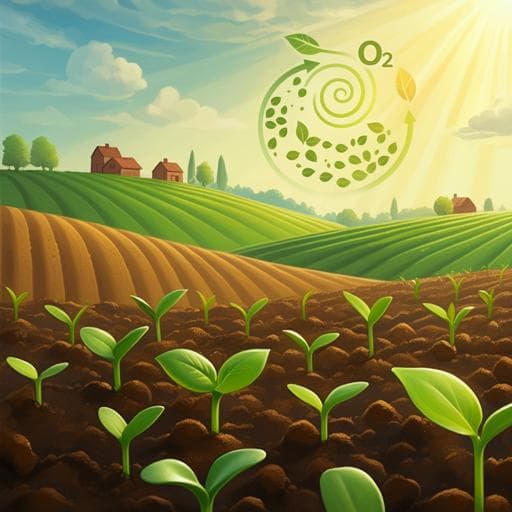
Environmental Studies and Forestry
A new scheme for low-carbon recycling of urban and rural organic waste based on carbon footprint assessment: A case study in China
K. Zhou, Y. Li, et al.
Discover how the innovative URIRP scheme, developed by authors Kai Zhou, Yongze Li, Yazhou Tang, Yuchen Yang, Ganpei Tian, Bo Liu, Bo Bian, and Chao He, revolutionizes low-carbon recycling of urban and rural organic waste in China, significantly reducing carbon emissions and enhancing nutrient recycling!
~3 min • Beginner • English
Introduction
The study addresses the challenge that urban and rural organic solid waste (UROSW) management is a significant source of greenhouse gases in China, a country responsible for roughly 30% of global carbon emissions. Current dominant disposal methods (incineration and landfilling) emit large amounts of CO2, CH4, and N2O. Despite efforts such as dehydration/drying, anaerobic digestion, and aerobic composting, treating each waste stream separately often results in high energy consumption and limited emission reductions. Prior estimates suggest that recycling solid waste could reduce global carbon emissions by up to 20%. The research question is how to design and evaluate a low-carbon, scalable, and economically viable utilization pathway for diverse UROSW streams at a regional/national scale. The purpose is to compare baseline practices with improved separate mitigation scenarios and with a proposed synergistic integrated scheme (URIRP) that emphasizes organic fertilizer and biochar production, quantifying environmental and economic benefits through life-cycle assessment and carbon footprint analysis.
Literature Review
The paper reviews resource utilization measures for organic wastes: (1) dehydration/drying to raise calorific value and produce biomass fuel; (2) anaerobic digestion to produce biogas, offsetting fossil fuel use; (3) aerobic composting to produce organic fertilizer enabling soil carbon sequestration. However, separate treatment of different waste types is inefficient and energy-intensive. Collaborative systems (e.g., industrial parks integrating sludge drying/incineration, garden waste treatment, combined heat and power, kitchen waste anaerobic digestion, and biogas use) can cascade materials and energy to reduce emissions. Co-composting advancements shorten maturation time, reduce nitrogen losses, and lower CH4 and N2O emissions. Biochar production via pyrolysis sequesters carbon long-term, reduces GHG emissions during composting, improves sludge dewatering, and produces co-products (bio-gas and bio-oil) for power generation, enabling fossil displacement. Despite these developments, an optimal regional-scale pathway across diverse urban-rural wastes for maximal carbon reduction remained unclear, motivating this study.
Methodology
Scope and wastes: UROSW includes municipal sludge (SS), kitchen waste (KW), garden waste (GW), straw (ST), livestock faeces (FA), biogas residue (BR), and cyanobacterial algal mud (DM), covering most UROSW types in China. Baseline was based on current practices in the Taihu Lake region (demonstration zone) and scaled nationally: SS dewatered to ~80% moisture then co-fired; KW via anaerobic digestion, biogas slurry treated as sewage; GW directly incinerated; ~92.4% of ST returned to fields; BR and DM dried then incinerated; FA mainly composted with ~25% landfilled.
Scenarios: Two mitigation scenarios for municipal organic solid waste (MOSW): MS1 (drying, boosting calorific value; KW biogas purified and injected to gas grid; organic residues used as actinomycete feed; biogas slurry to WWTP) and MS2 (sludge pyrolysis to biochar used as conditioner to deepen SS dewatering to ~60% moisture; GW shifted to aerobic composting; processing in industrial parks). Three rural scenarios for UOSW: CS1 (co-composting to produce organic fertilizer), CS2 (increase ST field separation rate to 8% and pyrolyze added ST), CS3 (produce biochar-based fertilizer by mixing biochar with GW, ST, FA, BR, DM).
URIRP integrated scheme: Builds on scenario insights to synergistically treat UROSW. Key elements: SS biochar (500 °C) plus aluminum salt enhancers to reduce press-filtered SS moisture to ~55%, then dry to 20% (≈8300 kJ kg⁻¹) and send to power plants to replace coal; KW pretreated for oil removal, anaerobically digested with conductive materials (e.g., magnetite) to boost CH4 by ~20%; purified biogas used as natural gas; biogas slurry (COD ≈ 5000 mg L⁻¹) used as carbon source at WWTP. A portion of ST is pyrolyzed at ~800 °C to biochar and then combined with BR, GW, FA, DM, and remaining ST for aerobic co-composting to yield biochar-based organic fertilizer (~10% biochar) for farmland. Tar and pyrolysis gas are sent to power plants for incineration to recover heat; electricity supplies the organic waste treatment park and heat is used for sludge drying; slag used as building material. The model closes loops of electricity, gas, and heat within an industrial park.
Data and forecasting: Provincial UROSW statistics from government and official sources (SS, KW, GW via area coefficients; ST and FA from National Bureau of Statistics; BR derived from KW; DM from lake stations). Population-based forecasting (2010–2021 data) using Logistic Population Model to project 2024–2030 populations (R² ≈ 0.964) and estimate UROSW outputs via historical per-capita generation coefficients.
Material Flow Analysis (MFA) and Carbon Footprint: System boundaries include collection through final utilization/disposal (Fig. 7 and S2). MFA tracks C, N, P across processes: KW treatment (KWD), SS dewatering/drying/incineration (SDI), co-production of biochar-based fertilizer (COF), composting with and without biochar (CNS, NS), and straw return (STT). Assumptions: main materials considered; annular distribution of UROSW relative to utilization point; when biochar/straw/organic fertilizer are returned to fields, C/N/P are treated as soil inputs; landfill/incineration treat C/N/P as losses. Carbon accounting includes: (1) indirect emissions from electricity, heat, chemicals, and terminal pollutant treatment (activity × emission factors); (2) direct uncontrolled GHG emissions from incineration, anaerobic digestion, and composting (mass-balance and emission factor methods); (3) carbon compensation via energy recovery (incineration power), mineral fertilizer substitution by organic fertilizers, and bio-oil/gas recovery.
Life Cycle Assessment (LCA): Conducted in SimaPro using ReCiPe 2016 with 22 midpoint and 3 endpoint categories. Environmental benefit analysis integrates MFA and LCA outputs (air pollutants, GHGs, solid waste, N/P recovery, soil quality improvements from replacing chemical fertilizer). Economic analysis uses cost/revenue parameters (Table S4), estimating processing costs and product revenues (construction/maintenance costs excluded); treatment costs reflect payments by polluters to treatment agencies.
Sensitivity analysis: Key parameters tested (Table S11). Composting CO2 and CH4 emission factors most influential (can change total GHG by +126% and +37%, respectively) due to the large role of composting and variable operating conditions. Despite variability, URIRP remains substantially lower in emissions than BS, MS2, and CS3. Anaerobic digestion methane yield significantly impacts carbon compensation, highlighting the importance of improving AD performance.
Key Findings
- Baseline (BS): China’s UROSW contains ~130 Mt of C; 43% landfilled, 31% fixed in soil, 26% emitted as CO2/CH4. Total GHG emissions ≈ 690 Mt CO2e yr⁻¹ (≈6% of China’s 2021 emissions). Indirect emissions dominate (>87%) from electricity, heat, and chemicals; heat alone ≈ 90.8 Mt CO2e yr⁻¹. Carbon compensation in BS is ~22.4 Mt CO2e yr⁻¹, mainly from incineration power (≈70%). Provinces with highest emissions include Sichuan, Henan, Hunan, Shandong, Yunnan, and Inner Mongolia (>40 Mt CO2e yr⁻¹ each).
- Separate mitigation scenarios: For MOSW, MS2 achieves 78% reduction versus current MOSW baseline and outperforms MS1 by 24 percentage points. For UOSW, CS3 yields the lowest emissions, reducing by 18% (1.2–1.6 percentage points better than CS1/CS2). Nationally under MS2+CS3, total emissions fall to ~320 Mt CO2e yr⁻¹; major provinces drop below ~30 Mt CO2e yr⁻¹.
- URIRP performance: Further reduces main indirect emissions by 87% versus BS and by 5% versus MS2+CS3, while increasing carbon compensation by 48% vs BS and 12% vs MS2+CS3. National emissions drop further to ~282–283 Mt CO2e yr⁻¹. Though pyrolysis/incineration of bio-oil and biogas increase emitted C by ~7.14 Mt, co-composting with biochar fixes ~93.35 Mt of C in soils, yielding ~130% more C to soils than BS. Provinces such as Sichuan, Henan, and Inner Mongolia decline to ~23–26 Mt CO2e yr⁻¹ each.
- 2030 outlook: Emission reductions of ~410 Mt CO2e yr⁻¹ could offset 6–8% of power sector emissions, 47.5% of metal processing, or 44–46% of agricultural sector emissions by 2030.
- Co-benefits: Air pollutant reductions relative to BS: particulate matter −21% (~12 Gg), SO2 −27% (~14 Gg), NOx −2% (~840 Gg). Secondary solid waste reduced by 33% (~0.84 Mt). Nutrient recycling improves (N and P recovery increase; reported as +23% and +0.1% in one analysis; overall >20% in conclusions). Topsoil organic matter increases by ~0.25% via biochar-based organic fertilizer use. Broad LCA endpoint damages decrease compared to BS: human health −17.6% (9.9 GPt), ecosystems −17.9% (0.6 GPt), resources −19.8% (0.2 GPt).
- Economics: Baseline national treatment costs ≈ $25.42B yr⁻¹ (most streams require subsidies; SS costs ~$1.8B). URIRP yields ≈ $8.78B profit yr⁻¹; SS dewatering costs reduced by ~70% via conditioners (ash residue/sludge char); dried SS power generation yields ~$51M; KW product revenue increases; coupling co-composting with straw carbonization produces high-value biochar-based fertilizer (~$230 t⁻¹) and pyrolysis oil (~$570 t⁻¹); pyrolysis gas largely meets process heat, keeping carbonization costs ~ $25 t⁻¹. When composting cost < $15 t⁻¹, combined composting+carbonization profits can reach ~$14.4B. Overall economic efficiency increases substantially (reported +135%).
Discussion
The study demonstrates that a synergistic, integrated approach (URIRP) to managing diverse urban and rural organic wastes can substantially reduce lifecycle GHG emissions and improve environmental outcomes beyond what is achievable by separate mitigation measures. By coupling anaerobic digestion, aerobic co-composting with biochar, and pyrolysis within an industrial-park framework, URIRP reduces dependence on grid energy and chemicals, enhances carbon sequestration in soils, and increases energy recovery (biogas, bio-oil/gas for heat/power). The shift from landfill/incineration dominance to resource recovery addresses the primary drivers of baseline emissions (indirect energy inputs and landfill methane). The approach is consistent with circular economy principles, increasing nutrient recycling, improving soil quality, and generating revenue—important for scalability and sustained adoption in developing contexts with large waste volumes. The carbon offset potential (6–8% of power sector emissions by 2030) and notable reductions in co-pollutants underscore URIRP’s relevance for national carbon neutrality and air quality goals. Remaining hotspots include composting-related emission factor uncertainty and high-output provinces where additional technology optimization (closed composting, tailored microbial agents) is needed to further curb CH4 and N2O.
Conclusion
China’s UROSW exceeds 2.5 billion tons annually, producing ~690 Mt CO2e yr⁻¹ under current practices. Separate urban/rural mitigation (MS2+CS3) can halve emissions to ~320 Mt CO2e yr⁻¹, while the proposed URIRP further reduces emissions to ~283 Mt CO2e yr⁻¹ by integrating MOSW and UOSW treatment with composting, anaerobic digestion, and pyrolysis to produce biochar-based fertilizer and bioenergy. By 2030, URIRP could reduce ~410 Mt CO2e yr⁻¹, offsetting ~6% of power sector emissions (or ~46% of agriculture). It increases UROSW resource recovery by ~21%, reduces particulate, SO2, NOx, and solid waste by 21%, 27%, 2%, and 33%, respectively, and enhances soil organic matter (~0.25%), improving crop yield and quality while boosting N and P recovery (>20%). Economically, URIRP transforms net costs into an estimated ~$8.8B annual profit. Future work should refine local implementations, further optimize composting emission controls and anaerobic digestion performance, expand waste source reduction, and test transferability to other countries with similar conditions.
Limitations
- Geographic scope: Detailed scenario calibration beyond Jiangsu Province is limited; regional economic and technological disparities imply heterogeneous real-world mitigation potentials (higher in developed regions, lower in underdeveloped ones).
- Parameter uncertainty: Composting CO2/CH4 emission factors show high variability, strongly influencing totals; although conclusions are robust, improved measurement and control are needed.
- Source reduction not fully captured: Additional gains depend on broader measures (reducing food waste and sewage discharges, improving lake ecology to curb cyanobacteria production).
- Operational constraints: Seasonal availability and decentralized distribution of certain wastes (e.g., straw) complicate logistics; successful national scaling requires robust collection, storage, and transport systems, standardized guidelines, and policy support.
- Economic assessment excludes plant construction/maintenance costs, which could affect net profitability in practice.
Related Publications
Explore these studies to deepen your understanding of the subject.







